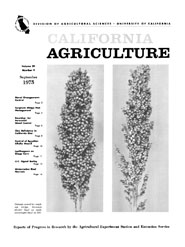


University of California
California Agriculture
|
|||
|
|||

Cover:
Damage carsed by sorghum midge. Severely blasted head on right; undamaged head on left.
September 1975
Volume 29, Number 9 News and opinion |
|||
|
University of California, 1301 S. 46th St., Bldg. 478 Richmond, CA
|